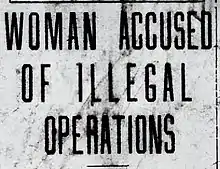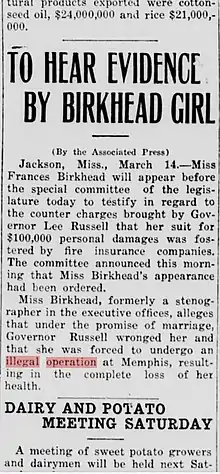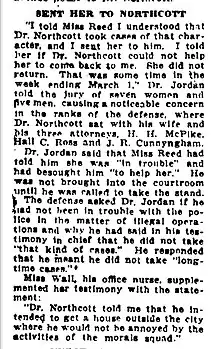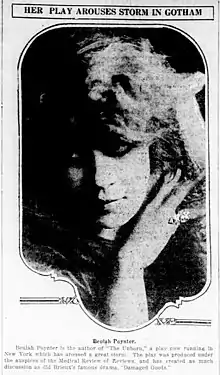
Illegal operation (sometimes criminal operation or illegal surgery) was a widely understood euphemism for induced abortion used in the 19th and 20th centuries in Anglophone countries including Australia, Canada, New Zealand, the United Kingdom, and the United States.[2][3][4][5][6][7] "Performing an illegal operation" could also be a criminal charge and/or the listed cause for the revocation of the medical license of an abortion provider.[4][8][9] The term was one of a number of euphemisms pertaining to sex, pregnancy, and childbirth.[2]
History
Background
The widespread criminalization of pre-quickening abortion occurred in the 1860s and 1870s.[10] Some feminists and midwives argue that "the era of dangerous, illicit abortion was a blip in history, less than 100 years," during which the criminalization itself meaningfully increased the physical risks to women.[11] Generally speaking, "the safety of illegal abortions varied according to the race and class of the patient"[12] since more expensive abortions were relatively more likely to be performed by experienced providers in sterile conditions.[13]
Despite the illegality of the procedure, women in Canada and the United States still procured hundreds of thousands of abortions annually through the 1950s and 1960s.[14] A 1937 New Zealand government study found induced abortion to be "exceedingly common" and estimated that approximately 6,000 were performed annually, 4,000 of which were done, in one way or another, "criminally."[15]
Limits on abortion-related language resulted from a mix of social mores and (in some jurisdictions) explicit legal prohibition.[6] In the U.S., the Comstock laws (which specifically prohibited selling or shipping "articles or medicines for the prevention of conception or procuring of abortion," along with a laundry list of other sexual material) led to heavy censorship across mass media.[16]
"The thing that had no name"
During the century between criminalization and legalization in the United States, "Abortion wasn't even whispered. It was referred to in newspapers as 'an illegal operation,' usually reported only when those who performed abortions were arrested or women who had abortions turned up in emergency rooms hemorrhaging, with raging infections, or dead."[17]
One Australian history described pre-legalization abortion as "the thing that had no name, that was known only as 'an illegal operation', 'tampering with the womb', 'a certain event', 'being interfered with' or 'bringing the courses on.'"[18]
"Illegal operation" could arguably describe any number of prohibited practices but was readily understood by the general public as specifically meaning induced abortion. Circa 1911 in Wisconsin, "[A 23-year-old woman] died 18 days…after undergoing a procedure that news reports coyly described as an 'illegal operation.' The papers didn't have to spell things out any further; their readers would know what that meant."[19] One local historian in Los Angeles, California, exploring the 1941 death of an aspiring model, noted, "Like most papers of this era, the [Los Angeles] Times rarely used the word 'abortion,' and preferred 'illegal operation.' Other euphemisms were 'criminally attacked' for rape and 'mistreated' [for] molestation."[20] When a woman's dismembered body was found in a suitcase floating near Boston Harbor in 1905, "the real scandal was that the body had recently undergone an illegal operation—an abortion. An operation so common that everyone reading the paper that day knew exactly what the headline referred to, but a crime so sensationalized, no one could utter its name."[21]

When illegal abortion appeared in the paper it was almost invariably as "scandal sheet" material. A survey of late-1920s New York City tabloid articles mentioning "illegal operation" found that they "consistently linked abortion to horrible consequences…these sampled sensational newspapers seemed to be sending a message that abortionists were immoral liars whose practice was filled with greed, fraud and abuse of women."[26] In 1918 a Chicago newspaper ran a series drawn from coroner's reports on women who had died from "illegal operations," it was intended to "warn young women of the dangers of seduction."[13] Abortion-related crimes were a gateway to coverage of sexual topics that would have otherwise been forbidden; "reports emphasise salacious descriptions, which were permitted only because they appeared as part of a court report, and would have been considered highly indecent in any other form of publication."[6] A historian studying deaths from illegal abortion in Washington state reported, "The news focused mostly on arrests, trials, and punishment, saying little about the victims, and never raising the issue of why these women were driven to take such risks."[27]
According to From Back Alley to the Border, a history of 20th-century criminal abortion in California, at a 1962 meeting about changing anti-abortion laws, a lawyer "explained it was rare to find instances of the word abortion in newspapers since it was a taboo subject, 'fit to be discussed only in medical journals.'" The lawyer said that despite the prohibition on that specific word, daily newspapers regularly reported on illegal operations and illegal surgeries, and argued that only with open discussion of the issue could the "problem" be addressed and resolved.[4]
By 1964, an Associated Press article headlined "Support Growing for Legalized Abortions" led with "Abortion is an ugly word for most people, synonymous with an illegal operation performed by an incompetent in a back room."[28]
Abortion euphemism elsewhere in print
Abortion was referenced in coded language throughout local newspapers. "Illegal operation" was typically deployed by news writers after the deed was done; classified advertisements also offered abortion services thinly disguised by euphemism.[29] According to an Australian historian, "The daily press regularly, if not frequently, reported on inquests into abortion deaths and about prosecutions for abortion-related crimes, and once the euphemisms are understood, it is clear that the advertisement columns [also] teemed with offers for abortion services."[6]
A survey found that 19th century newspaper classified ads for the sexual-health market "fascinate in their use of euphemism. Sexually transmitted infections are 'private diseases.' Pregnancy could be a 'disease peculiar to females.' An abortion, or the administration of abortifacient medicines, was not named as such, but described as the removal of an 'obstruction.'"[30]
Law

The phrase illegal operation also appears in criminal proceedings, usually related to deaths from unlawful abortions,[33][34][35] and occasionally in criminal charges against protection rackets extorting abortion rings.[36][37]
For example, in 1876 Massachusetts, the crime was "illegal operation upon a woman, with intent to procure a miscarriage."[38] One early 20th century Nebraska doctor who performed illegal abortions was charged nine times but "was acquitted or saw the charges dismissed in all but one instance, when he pleaded guilty to performing an illegal operation."[39][40]
A 1942 Michigan Supreme Court decision referenced the widely acknowledged meaning of the intentionally-opaque euphemistic terms associated with abortion:[41]
This claim is based upon the statement alleged to have been made by the declarant, as testified to by her mother, 'She said that she had had a criminal operation…asked her who did it. She said, Dr. Bradfield from Portland.' In People v. Fritch,supra, abortion is referred to as an illegal operation. The terms, abortion, illegal operation, and criminal operation, all have a common usage and, when criminal operation is used in such connection as in the case at bar, it must be considered a statement of fact and not merely an opinion or conclusion.
— People v. Bradfield, 1 N.W.2d 550 (Mich. 1942)
American case law and legal scholarship of this period often involves a woman's dying declaration about the circumstances of her "illegal operation."[4][42]
While the modern understanding of the word operation implies the use of surgical implements and cutting, in 1928 one Michigan doctor who pleaded guilty to the charges against him made a point to tell the judge, "There was no instrument used."[43]
A 1962 article about illegal abortions in Canada stated, "Under the vague law governing abortion in Canada almost no doctor can be confident that he will not be accused and convicted of carrying out an illegal operation if he performs an abortion, even in cases where the medical justification is clear."[44]
Art

Film
Following a total ban on abortion plotlines in the American film industry during the heyday of the Hays Code, the phrase appeared in the 1949 American film The Doctor and the Girl, "[which signaled] the return of veiled dialogue in abortion narratives as censor Joseph Breen compromised by allowing them to refer to 'an illegal operation'…Despite the vagueness of the phrase 'illegal operation', studios realized that the PCA had just allowed an abortion narrative on the screen."[48]
Television
In 1964, a character on the soap opera Another World who "refers to her 'illegal operation' that left her unable to bear children" was likely the first recurring or main character on American TV to claim an abortion.[49] (The Defenders, a groundbreaking legal procedural, had devoted an episode to the topic two years prior. The show's dialogue used the word abortion repeatedly;[50] all three of the show's usual sponsors declined to run commercials during that episode's ad breaks.)[51]
Program listings for episodes of late-1960s TV programs like The Mod Squad and Dr. Kildare also used "illegal operation" to describe abortion plot lines.[52][53]
Sculpture
The Illegal Operation is the title of a grotesque 1962 Edward Kienholz assemblage sculpture about unsafe abortion.[54]
Fiction
The 1968 Michael Crichton novel, A Case of Need, written under the pseudonym Jeffrey Hudson, is about criminal abortion in Boston and includes the line, "The trouble with this country…is that the women have no guts. They'd rather slink off and have a dangerous, illegal operation performed than change the laws. The legislators are all men, and men don't bear babies; they can afford to be moralistic."[55] The book is said to remain relevant to present-day readers "for its portrayal of how illegality makes everything worse."[56]
References
- ↑ "Woman Accused of Illegal Operations". San Francisco Call. Vol. 107, no. 81. 1920-04-09. p. 1. Archived from the original on 2022-09-04. Retrieved 2022-09-15 – via California Digital Newspaper Collection.
- 1 2 Rawson, Hugh (1981). A dictionary of euphemisms & other doubletalk : being a compilation of linguistic fig leaves and verbal flourishes for artful users of the English Language (1st ed.). New York: Crown Publishers, Inc. p. 67. ISBN 0-517-54518-7. OCLC 7279346.
- ↑ McLaren, Angus (1993-06-01) [Summer 1993]. "Illegal operations: women, doctors, and abortion, 1886-1939". Journal of Social History. Oxford University Press. 26 (4): 797–816. doi:10.1353/jsh/26.4.797. ISSN 0022-4529. PMID 11652328. Archived from the original on 2022-09-14. Retrieved 2022-09-03.
- 1 2 3 4 Gutierrez-Romine, Alicia (2020). From back alley to the border: criminal abortion in California, 1920-1969. Lincoln: University of Nebraska Press. ISBN 978-1-4962-2313-5. OCLC 1192499443.
- ↑ "AN ILLEGAL OPERATION". The Argus. Melbourne, Victoria. 1898-03-31. p. 6. Archived from the original on 2022-09-14. Retrieved 2022-09-05 – via Trove, National Library of Australia.
- 1 2 3 4 Parker, Clare (2013-01-01) [January 2013]. "Female Complaints and Certain Events: Silencing Abortion Discourse". Lilith: A Feminist History Journal. Canberra, Australian Capital Territory: Australian National University Press (19): 32–45. ISSN 0813-8990. Archived from the original on 2022-09-14. Retrieved 2022-09-06.
- ↑ Brooks, Vince (2014-12-18). "Hampton Coroner Records Reveal Social History". The UncommonWealth, Library of Virginia. Archived from the original on 2022-09-06. Retrieved 2022-09-06.
- ↑ Kershner, Jim (2018-05-09). "100 years ago in Spokane: Midwife denies performing abortion". The Spokesman-Review. Spokane, Washington. Archived from the original on 2022-09-03. Retrieved 2022-09-03.
- ↑ "Illegal Operations". Pahiatua Herald. Vol. XXXIV, no. 10334. Pahiatua, Manawatū-Whanganui. 1926-09-04. p. 5. Archived from the original on 2022-09-06. Retrieved 2022-09-05 – via Papers Past, National Library of New Zealand.
- ↑ Reagan, Leslie J. (2022-06-01). "Abortion Used to Be No Big Deal. A Few Angry Men Made It One". Slate. ISSN 1091-2339. Archived from the original on 2022-09-01. Retrieved 2022-09-16.
- ↑ Block, Jennifer (2019). "Chapter 7: The Case for Home Abortion". Everything below the waist: why health care needs a feminist revolution. New York: St. Martin's Press. ISBN 9781250110053. OCLC 1048944643.
- ↑ Waller, Derek (2014-04-09). "An Illegal Operation: The Case of Theresa Solie". The Historyapolis Project. Minneapolis, Minnesota: Augsburg College. Archived from the original on 2022-09-15. Retrieved 2022-09-15.
- 1 2 Reagan, Leslie J. (1997). When Abortion Was a Crime: Women, Medicine, and Law in the United States, 1867-1973. Berkeley, California: University of California Press. ISBN 9780520216570. OCLC 34789572. Archived from the original on 2008-05-13. Retrieved 2022-09-06 – via California Digital Library (UC Press E-Books Collection, 1982-2004).
- ↑ Stevenson, Robin; Fitzgerald, Meags (2019). My body, my choice: the fight for abortion rights. Victoria, British Columbia: Orca Book Publishers. ISBN 978-1-4598-1712-8. OCLC 1050133570.
- ↑ McMillan, David Gervan; Fraser, Janet; Chapman, Sylvia G.; Corkill, Thomas F.; Paget, Tom L. (1937). Report of the Committee of Inquiry into the Various Aspects of the Problem of Abortion in New Zealand. Wellington, Wellington Region: E. V. Paul, Government Printer. Archived from the original on 2022-09-15. Retrieved 2022-09-15 – via Project Gutenberg.
- ↑ Werbel, Amy Beth (2018). Lust on trial: Censorship and the rise of American obscenity in the age of Anthony Comstock. New York: Columbia University Press. ISBN 9780231547031. OCLC 1007499221.
- ↑ Neville, Anne (2002-11-25). "'I was doing something illegal'". The Buffalo News. Buffalo, New York. ISSN 0745-2691. Archived from the original on 2022-09-03. Retrieved 2022-09-03.
- ↑ Wainer, Jo (2007-01-01). "Lost: Illegal Abortion Stories". Reproductive Health Matters. 15 (29): 155–159. doi:10.1016/S0968-8080(06)29281-4. ISSN 0968-8080. S2CID 72551009.
- ↑ Macreth, Bob (2022-07-27). "An Ashland abortion gone wrong". Ashland Daily Press. Ashland, Wisconsin. Archived from the original on 2022-09-04. Retrieved 2022-09-04.
- ↑ Harnisch, Larry (2011-11-19). "Hollywood Model Dies of Botched Abortion, Nov. 19, 1941". The Daily Mirror. Archived from the original on 2013-02-09. Retrieved 2022-09-15.
- ↑ Masarik, Elizabeth Garner (2018-02-05). "The Suitcase Murder: Abortion, Mystery and Murder in 20th Century America". DIG Podcast. Archived from the original on 2022-09-09. Retrieved 2022-09-09.
- ↑ Woodrick, Jim (2012-10-15). ""And speaking of which...": The Gentleman from Lafayette". "And speaking of which..." A Mississippi History Blog. Archived from the original on 2021-06-21. Retrieved 2022-09-17.
- ↑ Hargrove, David M. (2019). "Chapter 7: Enforcing the National Prohibition Act, 1919–1929". Mississippi's Federal Courts: A History. University Press of Mississippi. ISBN 9781496819499. OCLC 1038445778. Retrieved 2022-09-16 – via Google Books.
- ↑ Southwick, Leslie H. (2015). "Four for the Fifth: The First Mississippi Judges on the Fifth Circuit". Mississippi College Law Review. 34 (3): 241. Archived from the original on 2021-05-16. Retrieved 2022-09-17.
- ↑ "To Hear Evidence by Birkhead Girl". The Log Cabin Democrat. 1922-03-14. p. 1. ISSN 2692-9090. OCLC 12956845. Archived from the original on 2022-09-21. Retrieved 2022-09-16 – via Chronicling America, National Digital Newspaper Program, Library of Congress.
- ↑ Olasky, Marvin (1989-09-01). "Abortion News in the Late 1920s: A New York City Case Study" (PDF). Journalism & Mass Communication Quarterly. 66 (3): 724–726. ISSN 1077-6990. Archived (PDF) from the original on 2022-09-03. Retrieved 2022-09-04 – via Sage Journals.
- ↑ Gregory, James (2013). "When Abortion was Illegal (and Deadly): Seattle's Maternal Death Toll". Seattle Civil Rights & Labor History Project. University of Washington. Archived from the original on 2022-08-06. Retrieved 2022-09-15.
- ↑ Boyarsky, Bill (1964-03-18). "Support Growing for Legalized Abortion". Santa Cruz Sentinel. Santa Cruz, California. p. 26. Archived from the original on 2022-09-04. Retrieved 2022-09-04.
- ↑ Thompson, Lauren MacIvor (2019-12-13). "Women Have Always Had Abortions". The New York Times. ISSN 0362-4331. Archived from the original on 2022-09-06. Retrieved 2022-09-06.
- ↑ Onion, Rebecca (2014-08-06). "19th-Century Classified Ads for Abortifacients and Contraceptives". Slate. ISSN 1091-2339. Archived from the original on 2022-09-06. Retrieved 2022-09-06.
- ↑ Staff Correspondent (1919-06-25). "Witnesses Tell of Sending Nurse Inez Reed to Office of Northcott - STATE OFFERS NEW EVIDENCE IN REED TRIAL - Doctor and Nurse Testify They Directed Dead Girl to Defendant - MESSAGE IS REPEATED - Woman Says She Was Employed to Attend Victim Later Discharged". San Francisco Chronicle. p. 13. ISSN 1932-8672 – via ProQuest Historical Newspapers - San Francisco Chronicle (1865-1922).
- ↑ Redmond, Jennifer Ann (2019-05-28). "This Was Abortion in 1919. We're Going Back There". Medium. Archived from the original on 2022-09-04. Retrieved 2022-09-04.
- ↑ Helquist, Michael (2015). ""Criminal Operations": The First Fifty Years of Abortion Trials in Portland, Oregon" (PDF). Oregon Historical Quarterly. Oregon Historical Society. 116 (1): 6. doi:10.5403/oregonhistq.116.1.0006. ISSN 0030-4727. S2CID 159801054. Archived (PDF) from the original on 2022-09-03. Retrieved 2022-09-04.
- ↑ Christman, Roger; Archives (2014-10-20). "Mug Shot Monday: Dr. Robert S. Fitzgerald, No. 38685". The UncommonWealth, Library of Virginia. Series: Inmate Photographs in the Records of the Virginia Penitentiary. Archived from the original on 2022-09-04. Retrieved 2022-09-04.
- ↑ Callanan, Tim (2019-12-29). "The mysterious motivations of notorious serial abortionist Elizabeth Taylor". ABC News. Sydney, New South Wales. Archived from the original on 2022-09-06. Retrieved 2022-09-06.
- ↑ "ILLEGAL OPERATION PAY-OFFS CLAIMED". Los Angeles Times. 1950-07-13. p. 15. ISSN 0458-3035.
- ↑ "2 Detectives Indicted in Beach Extortion Case: Pair Accused of Shakedown of Doctor Under Threat of Illegal Operation Charge". Los Angeles Times. 1960-09-14. p. 2. ISSN 0458-3035.
- ↑ "COMMONWEALTH vs. DAVID R. BROWN, 121 Mass. 69 (May 15, 1876–October 20, 1876, Suffolk County)". masscases.com. Archived from the original on 2020-02-24. Retrieved 2022-09-05.
- ↑ Stoddard, Martha (2022-06-05). "Before Roe v. Wade, some Nebraska abortion practitioners faced prosecution". Omaha World-Herald. Omaha, Nebraska. Archived from the original on 2022-09-03. Retrieved 2022-09-03.
- ↑ Tallman, Jamie Q. (2011). The notorious Dr. Flippin: abortion and consequence in the early twentieth century. Lubbock, Texas: Texas Tech University Press. ISBN 978-0-89672-675-8. OCLC 691204314.
- ↑ "People v. Bradfield, 1 N.W.2d 550, 300 Mich. 303 – CourtListener.com". CourtListener. Archived from the original on 2022-09-03. Retrieved 2022-09-03.
- ↑ "Criminal Law. Evidence. Charge of Illegal Operation on a Woman. Statements of Deceased Woman as to Operation". The Virginia Law Register. 18 (10): 789–790. 1913. doi:10.2307/1105196. JSTOR 1105196. Retrieved 2022-09-09 – via JSTOR.
- ↑ Sault Ste. Marie Public Library Archives (2019-09-08). "Death and the abortion doctor: Final chapter". SooToday.com. Sault Sainte Marie, Michigan. Archived from the original on 2022-09-07. Retrieved 2022-09-07.
- ↑ Mair, Shirley (1962-11-03). "A national report on THE ABORTION MILLS AND THE LAW". Maclean's. Toronto, Ontario. ISSN 0024-9262. Archived from the original on 2022-09-03. Retrieved 2022-09-03.
- ↑ "Her Play Arouses Storm in Gotham". Rock Island Argus. Vol. 65, no. 57. Rock Island, Illinois. 1915-12-23. p. 3. Archived from the original on 2022-09-08. Retrieved 2022-09-08 – via Illinois Digital Newspaper Collections.
- ↑ Luter, Gary S. (1981). Sexual Reform on the American Stage in the Progressive Era, 1900-1915 (Ph.D.). Gainesville, Florida: University of Florida. pp. 161–164. OCLC 08375855.
- ↑ "New Sensation Play Promised - 'Damaged Goods' Will be Gone One Better, Say Advanced Reports". South Bend News-Times. South Bend, St. Joseph County, Indiana. 1915-10-13. Archived from the original on 2022-09-08. Retrieved 2022-09-08 – via Hoosier State Chronicles: Indiana's Digital Historic Newspaper Program.
- ↑ Kirby, David A. (2017-09-19). "Regulating cinematic stories about reproduction: pregnancy, childbirth, abortion and movie censorship in the US, 1930–1958". The British Journal for the History of Science. Cambridge University Press. 50 (3): 451–472. doi:10.1017/S0007087417000814. ISSN 0007-0874. PMID 28923130. S2CID 13658330.
- ↑ Fisher, Luchina; Messer, Lesley (2018-10-15). "How the portrayal of abortion in TV and film has shifted since 1928". Good Morning America. Archived from the original on 2022-09-04. Retrieved 2022-09-04.
- ↑ CBS; Plautus Productions (1961), The Defenders - Complete Season 1 - Uploaded by Tee Vee Classics, retrieved 2022-09-10 – via Internet Archive
- ↑ Bowie, Stephen (2008-08-15). "Benefactors". The Classic TV History Blog: Dispatches from the Vast Wasteland. Archived from the original on 2022-09-10. Retrieved 2022-09-10.
- ↑ "TV Daily Log". Desert Sun. Vol. 43, no. 43. Palm Springs, California. 1969-09-23. p. 10. Archived from the original on 2022-09-04. Retrieved 2022-09-04 – via California Digital Newspaper Collection.
- ↑ "TV Week". The Sun-Telegram. Vol. 19. San Bernardino, California. 1966-03-27. p. 89. Archived from the original on 2022-09-04. Retrieved 2022-09-04 – via California Digital Newspaper Collection.
- ↑ "The Illegal Operation (LACMA Collections)". Los Angeles County Museum of Art. Archived from the original on 2022-09-03. Retrieved 2022-09-03.
- ↑ Hudson, Jeffrey (1969). A case of need. New York: Signet. ISBN 0-451-18366-5. OCLC 32437038.
- ↑ Hansen, John (2021-09-06). "'A Case of Need' (1968) makes case as Crichton's first gem". Reviews from My Couch. Series: Michael Crichton Mondays. Archived from the original on 2022-09-06. Retrieved 2022-09-06.